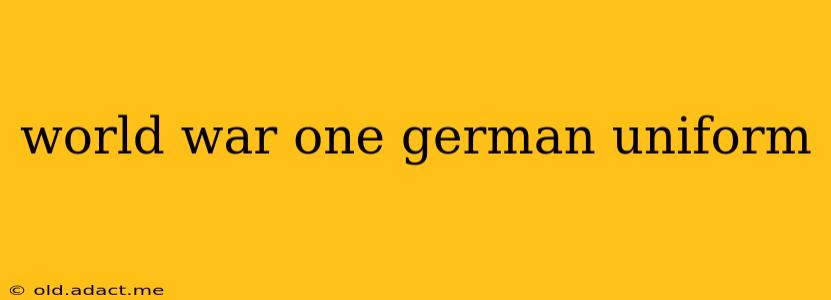World War One saw the German Empire field a vast army, and understanding their uniforms provides a fascinating glimpse into the military organization and societal context of the time. This guide will delve into the intricacies of the German WWI uniform, exploring its evolution, variations, and the symbolism it represented. We'll also address some frequently asked questions surrounding this topic.
What did a typical German soldier's uniform look like in World War One?
The typical German soldier's uniform in World War One was characterized by its grey-green color, a significant departure from the Prussian blue of earlier eras. This pragmatic choice offered superior camouflage in the varied battlefields of the Western Front. The uniform itself consisted of a tunic (jacket), trousers, and a cap. Early war uniforms featured more elaborate details, including brightly colored facings (the trim on the collar and cuffs) that identified the soldier's regiment or branch of service. However, as the war progressed, these embellishments were often simplified for practical reasons.
The tunic was typically long and buttoned, often with breast pockets. The trousers were usually straight-legged and tucked into boots. Headgear varied, with the Pickelhaube, a spiked helmet, being common at the outset of the war but gradually replaced by the more practical field cap (Schirmmütze).
What were the different types of German uniforms in WWI?
German WWI uniforms varied significantly depending on the soldier's role and branch of service. Here are a few examples:
- Infantry: The most common type, characterized by the grey-green tunic and trousers described above.
- Artillery: Artillerymen often wore similar uniforms but might have had specialized equipment or pouches for their duties.
- Cavalry: Cavalry uniforms were often more elaborate, with distinctive features like longer coats and distinctive headgear.
- Officers: Officer uniforms were generally more ornate than those of enlisted men, featuring more elaborate braids, buttons, and insignia.
- Medical Corps: Medical personnel wore uniforms that were easily identifiable, often with a distinctive red cross emblem.
What were the materials used to make German WWI uniforms?
The materials used in German WWI uniforms reflected the resources available and the harsh realities of trench warfare. Wool was a primary material for the tunics and trousers, chosen for its warmth and durability. However, as the war progressed and resources dwindled, cheaper and less durable materials were sometimes used, impacting the quality and longevity of the uniforms.
How did German uniforms change throughout World War One?
As the war dragged on, the German army made several changes to its uniforms, driven primarily by practicality and resource constraints. Early war’s elaborate details gave way to simpler designs. The use of camouflage patterns also increased as the war progressed, and the iconic Pickelhaube was largely replaced by the more practical field cap. The changes aimed to increase functionality and ease of production.
What is the significance of the German WWI uniform?
The German WWI uniform serves as a powerful symbol of a bygone era. It represents the immense scale of the conflict, the human cost of war, and the complex societal forces that shaped the conflict. Studying the uniform helps us understand the organization of the German army, the role of military tradition, and the technological and logistical challenges of waging total war. Studying these uniforms provides critical insight into the social and military history of Germany and WWI.
Were there any regional variations in German WWI uniforms?
While the overall design of German WWI uniforms was standardized, there were subtle regional variations, particularly in the details and accessories. Some regiments or units might have maintained local traditions or incorporated regional features into their uniforms. These small variations often reflected local pride and traditions.
How can I identify a genuine World War One German uniform?
Authenticating a WWI German uniform requires expertise and a careful examination of several factors, including the materials, construction techniques, buttons, insignia, and overall condition. Be wary of fakes and reproductions, and seek expert advice if unsure about the authenticity of a particular item. Research and comparison with known examples are also very useful.
This exploration of the German WWI uniform provides a starting point for further investigation into this fascinating aspect of military history. The changes, variations, and the symbolic representation of the uniform provide valuable insights into the experience of the German soldier in the Great War.
